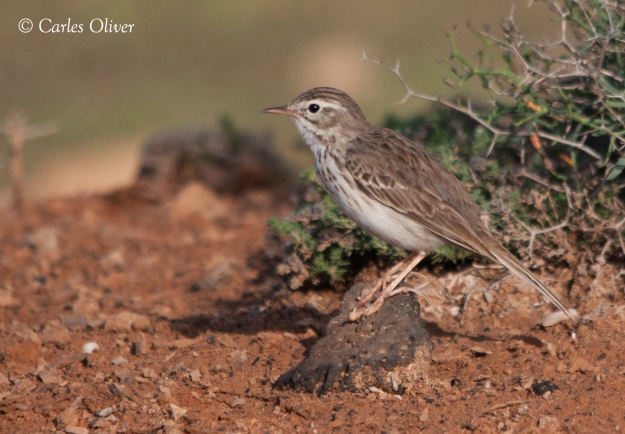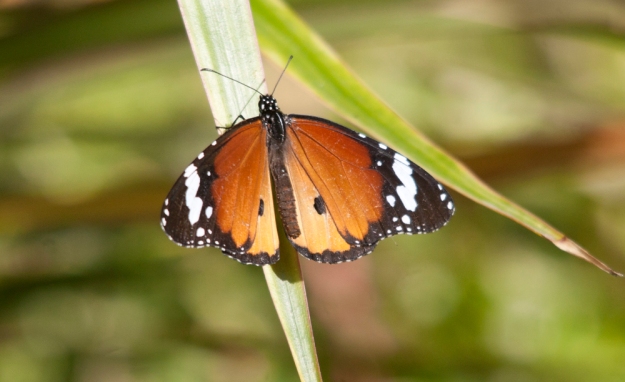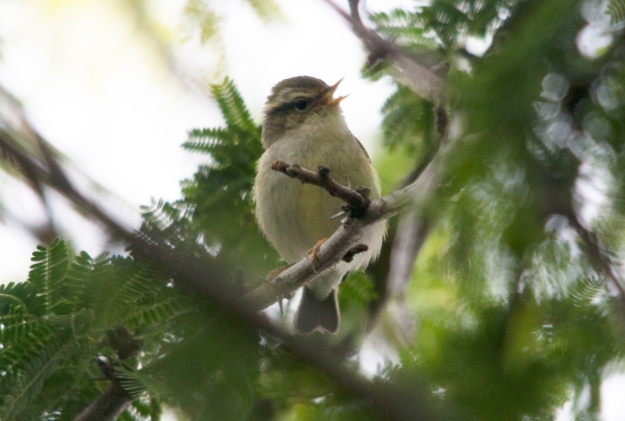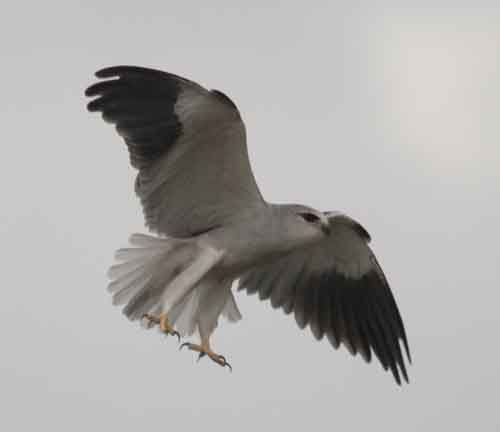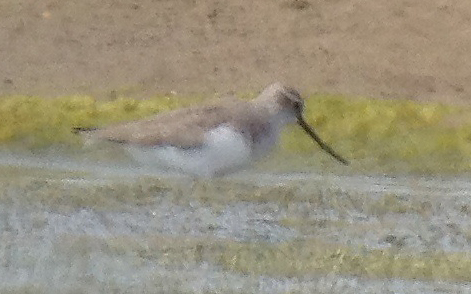Dates: December 6th to 10th, 2016
Number of participants: 3
Weather conditions: Sunny all long. We had, as usual, early morning clouds but breaking after 10am. A soft brise was also present most of the days. Temperatures; 18ºC to 24ºC.
Day 1. December 7th. After our late afternoon arrival to Fuerteventura from our Barcelona flight we woke up early in our seaside hotel in El Cotillo to enjoy a good breakfast before starting birding. Still, in the gardens of our hotel a first of many, many Spanish Sparrows (Passer hispanoliensis) was spotted doing its typical call. This is the only one species of Sparrow living in the island being really common in every single garden! After breakfast we did the short transfer to our first location. El Cotillo-La Oliva area is a well known area for steppe birds, hosting most (if not all) the especialities living in the island. In our first stop we soon located some Berthelot’s Pipits (Anthus berthelotii), the first Canary Islands endemic of the trip, along with several very vocal Lesser Short-toed Lark (Calandrella rufescens).
Some scanning around produced 2 Hoopoes (Upupa epops) landing on some rocks, one of them doing its wonderful song. A male European Stonechat (Saxicola rubicola) was spotted in the steppe and broke some hearts as a close relative of it was expected instead… still, this was the only European Stonechat of trip!
In our way to our very first important stop we enjoyed views on Canary Islands Ravens (Corvus corax tingitanus), a superb and very different bird from European race due to their shorter tail, more rounded wings, smaller head and very distinctive (rather crow-like) calls. This a good candidate for a future split… In the distance, some Stone Curlews were calling but we could not locate them…
Once we stopped we immediatly spotted a magnificient Houbara Bustard (Chlamidotis undulata) preening about 100 metres away from us. The bird was really concentrated in cleaning its plomage so we could enjoy it as long as necessary to have excellent views. At the same time we kept scouting looking for some females but we had no luck… Instead we had some really confiding Canary Islands Shrikes (Lanius (elegans) koenigi) around. The status of this bird is still controversial. Nowadays there are two main theories; the first arguing to be a different species (Lanius koenigi), the second (and more accepted) arguing to be conspecific with Desert & Algerian Shrikes (Lanius elegans koenigi), and still some other theories. Wherever these birds were really cooperative and photographers appreciated very much really close views on them.
We kept scanning ditches around and our work proved not to be unhelpful since we had 2 Barbary Partridges (Alectoris barbara) feeding in one of the ditches. It was a great spot since this can be a difficult bird to spot so it was great to have so early in the trip!

Canary Island Shrike (Lanius (elegans) koenigi) is a splitable endemic easy to find in Fuerteventura.

Barbary Partridges (Alectoris barbara) can be difficult to spot but we had several good sights on them.
After such a good start we decided to explore a small canyon (barranco) close by. Several Berthelot’s Pipits were around and here we had very good views on some really confiding Spectacled Warblers (Sylvia conspicillata orbitalis). We decided to walk a bit up the “barranco” and, after only 100 metres of walk we found an extremelly close Fuerteventura Chat (Saxicola dacotiae) male on a Cactus. Soon after we found the beautiful female around and enjoyed of very long and close views on them. This is the only endemic bird of Fuerteventura and one of the main target birds for any single birdwatcher visiting the island…

Fuerteventura Chat (Saxicola dacotiae) is restringed to this island and a must for any birdwatcher visiting it!
While enjoying the chats we also had another good encounter since a small flock of about 6 Trumpeter Finches (Bucanetes githagineus) came to stop only 20 metres from us! Again, we could enjoy them quite long while feeding on seeds in tiny bush. A few after a Common Buzzard (Buteo buteo insularum) appeared in the sky. This is again an endemic race of the Canaries, and a bird that looks like quite different from continental forms! In this barranco we also had our firsts Greenish Black-tips (Elphinstonia charlonia) moving around along with Painted Ladys (Vanessa cardui) and 1-2 Red Admirall (Vanessa atalanta).
After such a wonderful mid-morning we decided to have a change and go to Los Molinos reservoir, the main wetland in the island. In our way to the reservoir we stopped a pair of times to enjoy some flocks of Spanish Sparrows. Linnet (Carduelis cannabina), Eurasian Collared Dove (Streptopelia decaocto) and Robin (Erithacus rubecula) were also seen. Our last stop produced also 2 Laughing Dove (Streptopelia senegalensis) but, unfortunately I was the only one to see them…
Even before arriving to Los Molinos reservoir we started to enjoy the visit. Birding in this location is highly variable depending on water level but this time we were lucky, as water level was high and the whole “barranco” beyond the dump was having water running down. 1 Common Kestrel (Falco tinnunculus dacotiae) was gliding over and allowed us excellent views on this (again) endemic race! Ruddy Shelducks (Tadorna ferruginea) we common this year as we count no less than 60 of them in the lake! When approaching the reservoir we had really close views on them. Some of the birds around included Eurasian Coot (Fulica atra) +70, Common Sandpiper (Actitis hypoleucos) 2, Greenshank (Tringa nebularia) 3, Little Ringed Plover (Charadrius dubius) 1, Black-headed Gull (Chroicocephalus ridibundus) 1, Tufted Duck (Aythya fuligula) 6, Eurasian Teal (Anas crecca) 2, Common Snipe (Gallinago gallinago) 2 and 3 Little Egret (Egretta Garzetta).

Lesser Short-toed Larks (Calandrella rufescens) are good imitating other birds. This bird imitated Fuerteventura Chat, Stone Curlew and Berthelot’s Pipit amongst other birds.
The best birds in the wetland this time were +15 Black-winged Stilts (Himantopus himantopus) and one unexpected Garganey (Anas querquedula). Here we also had our only one Northern Wheatear (Oenanthe oenanthe) of trip, perched on a wall along with Canary Islands Shrike & Hoopoe, good combination of birds! It was lunch time so we head to a close place to enjoy some food and, why not, some shade! Before that we had to do an emergency stop since a Egyptian Vulture (Neophron percnopterus majorensis) was spotted perched in one slope. Despite the bird was quite far away, we enjoy good views on the bird while feeding around joined by a pair of Ravens… This was a good spot and, surprisingly, our only Egyptian Vulture in this trip!
After lunch we came to the semi-desert area around El Cotillo. Here we spent some time scanning some farming areas, where we had 2 Barbary Partridges and our only one Song Thrush (Turdus philomelos) of trip. A short drive around the area produced our main target that afternoon since 3 obliging Cream-coloured Coursers (Cursorior cursor bannermani) were located, doing their typical short runs. They were really cooperative and delighted the whole group! Nevertheless it was considered one of the birds of the trip!! 

We hept moving in this area, having always confiding Berthelot’s Pipit around. Not long after we had a flock of 5 Black-bellied Sandgrouses (Pterocles orientalis) flying not far away from us… They stopped in a hill but, as we had not so much light left, we decided to move.
We still had to have a last stop. After a short transfer we arrive to an area were one of the main targets of the trip is normally moving. A short wait was done in late afternoon light and then, with the very last light, it was appearing a wonderful Barbary Falcon (Falco peregrinoides) with a prey, flying fast around the valley! We were lucky as the bird decided to do a pair of rolls in the air so we could have good views on the falcon before desappeared! We were all really happy of having such a view on a bird that many birdwatchers visiting the island are missing!! The population here is tiny, probably only 2-3 pairs!! Happy after such a successful day, we head back to our hotel for some rest (& good food!).
Day 2. December 8th. After the success of the day before, we decided to do a pre-dawn start and go to the same place where we had our first Houbara Bustard the day before. When we arrived to the place the bird was immediatly located and we were delighted to see it in full display! It was evident that that place was his lek this year. Displays of Houbara Bustard are really spectacular and even funny. Males place the head rear on their back and then open and show all white feathers in their breast and along the neck. Once in this position, the bird starts running in small, 5-6 metres of diameter cercles. Like this, the bird looks like having no neck, neither head. It looks like a running snow ball, actually! We enjoyed very much of such a exhibition, that was repeated several times. Unfortunately the bird was a bit far away to take any proper photo… After such a good start in our second day we decided to do some further exploration in the same area, that was soon producing to more distant males displaying in different corners, in the semi-arid countryside. No females were spotted, suprisingly!
When we were about to leave the area we had a wonderful Stone Curlew (Burhinus oedicnemus insularum) sat down some meters away from our car! This was a wonderful spot and photographers in the group (once again) really appreciated it! Stone Curlews living in Canary Islands are, in average, darker and more contrasted than those living in Africa and are good candidates for a future split.

Stone Curlews (Burhinus oedicnemus insularum) are not uncommon in Fuerteventurs, but always challenging to find.
After leaving the semi-desertic area we headed towards maybe the only one reliable spot for Atlantic Canary (Serinus canaria) in Fuerteventura. We arrived quite at midday to the place and soon after parking we had a male Sardinian Warbler (Sylvia melanocephala) singing close by. This sight was followed by our only one seen Blackcap (Sylvia atricapilla) of the trip. After some meters of exploration we listened some Canaries moving up the slope, at the other side of the barranco, so we headed to that area and soon we were enjoying a wonderful, 4-5 metres away male singing and calling from its perch. As an interesting point, this male looked like being imitating the calls of African Blue Tits… never listened thst before. This finch is also an endemic bird but this time shared by Canary Islands, Maderia and Açores.

Atlantic Canary (Serinus canaria) is Macaronesian endemic having a tiny population in Fuerteventura.
We counted up to 4 Atlantic Canaries in the slope, not a big number but enough for the small group! Several obliging Spectacled Warblers were also very active in that slope, singing from the bush land but also performing song flights so we invested some time in having even better views than the previous day! Even before being back to the village we had our last target bird in this location, as 1 African Blue Tit (Cyanistes teneriffae ultramarinus) was seen flying over our heads. We followed this bird to have better views and soon were enjoying really close views on two individuals in a dense tree, joined by 2 Chiffchaffs (Phylloscopus collybita).
We also had some wonderful butterflies here, including the first Plain Tiger (Danaus chrysippus) of the trip, Geranium Bronze (Cacyreus marshallii) and +5 Bath White (Pontia daplidice). A Blue butterfflie was also flying around but couldn’t have proper views on it…

Bath White (Pontia daplidice) is probably the commonest butterfly in the mountainous orchads in Fuerteventura.
We leaved Betancuria for our next stop, this time in the South part of the island. After lunch we arrived to the area around Oasis Park Fuerteventura, where so scaped birdlife can be seen. Just a few miles before arriving a new Laughing Dove was spotted crossing the road in flight. Again I was the only one in having the bird our efforts in recolate the bird were useless. Once we arrived to the are around Oasis Park we had some good views on impressive Monarch (Danaus plexippus) joined by some Plain Tigers (Danaus chrysippus). These butterflies were really celebrated by the group! We did some walks around but only had 3 Chiffchaffs, +2 Blackcaps singing from some bush, 1 Robin and the omnipresent Spanish Sparrows & Collared Doves… A bit more of effort was done and we finally got something as 1 Red-vented Bulbul (Pycnonotus cafer) was appearing and showing well (although distant) in the top of one tree. It looks like there is a small population breeding around this zoo. We still had some more time around but only produced a small Common Waxbill (Estrilda astrild) flock calling inside a fenced area…

Red-vented Bubul (Pycnonotus cafer), an scaped that is probably having a tiny self-sustained population.
We decided to change our location and explore the urban “forest” at Costa Calma. We found the place really quiet and for 10-15 minutes we only had 2 Chiffchaffs… and Spanish Sparrows. But when thinking about leaving the area we spotted a wonderful Yellow-browed Warbler (Phylloscopus inornatus). We approached the bird until we could have really good views (and shots) and then is when we realised a second YB was calling deeper inside the canopies! That was a really good bird a quite celebrated. We still had some more time is this spot, hoping for something different but we only got a flock of 7-8 Eurasian Goldfinches (Carduelis carduelis).
It was only one hour left until dark so we decided to explore some semi-desert areas around Costa Calma. Right when arriving to the designated place we had a wonderful flock of 13 Black-bellied Sandgrouses that allowed a long sight while feeding on ground in the afternoon light. A short drive after this encounteer we also had really good views on 2 close Cream-coloured Coursers showing really well! We still had time for a further exploration and got what we were looking for… 2 magnificient females Houbara Bustards feeding close by, in lovely sunset light. This time we really enjoy the way they delicatelly feeding on the bush around and how they were running around in the middle of the steppe land!
An amazing view to end a wonderful second day of the trip!!
Day 3. December 9th. This day we were supposed to “jump” to Gran Canaria to add some different species and, especially, the really scarce Gran Canaria Blue Chaffinch (Fringilla polatzeki). Unfortunately this option was finally not possible and we had to stay in Fuerteventura. We invested the morning in scan the shore around El Cotillo. Here we spotted Eurasian Whimbrels (Numenius phaeopus) in several spots as well as Common Ringed Plover (Charadrius hiaticula). Along the coast several Yellow-legged Gulls (Larus michahellis atlantis), a slightly smaller and less powerful race if compared with the nominal race living in the Mediterranean. Other birds appearing here include 2 Sandwich Terns (Sterna sandvicensis), 3 Lesser Black-backed Gull (Larus fuscus) and my first ever Trumpeter Finch by the sea! The best birds along the morning, still, were located around El Cotillo, where we had +13 Kentish Plover (Charadrius alexandrinus), 3 Dunlin (Calidris alpina), 1 Little Stint (Calidris minuta) and 1 Grey Plover (Pluvialis squatarola).
Several stops were done to scan the sea, looking for Shearwaters or other sea birds but, unfortunately, nothing of interest was spotted along the whole morning… After lunch we came back to the semi-desert area, trying to have a second look on Barbary Falcon. We explored the same area where we had the bird a pair of days before but we had no luck. Instead we got a new flock of 4 Black-bellied Sandgrouses, really close views this time, as well as a lovely view on a pair of Barbary Partridges that, this time, was allowing good shots.
Day 4. December 10th. Last morning in the island. We decided to have a last look to the semi-desert specialities. 3 Houbara Bustards were located again easily but the best of that visit was 1 Stone Curlew close by the dart road. After this good start we decided to go for Laughing Dove (Streptopelia senegalensis), a species that had been escaping from us, so far. We stopped in the same area I spotted two individuals a pair of days ago and we were lucky since we had a really good view on a bird perched in a wire even before leaving the car!

Laughing Dove (Streptopelia senegalensis) is a pretty scarce dove in the Canary Islands, and beautiful bird!
As we were close to Los Molinos reservoir we spent some time there, as well. New and excellent views on Fuerteventura Chats and Trumpeter Finches were done and allowed good photos. We also added some new species to the tour list. 5 Mallards (Anas platyrhynchos) were seen along with 2 Pintails (Anas acuta), 2 Eurasian Wigeons (Anas penelope) and 4 Grey Herons (Ardea cinerea) but the best birds in this stop were the flocks of at least 18 Black-bellied Sandgrouses flying really low all around and stopping to drink water around the reservoir! It was a lovely view and quite unexpected, actually! 

Female & male Fuerteventura Chats (Saxicola dacotiae), personally the besg bird living in Fuerteventura!
Right before arriving to the airport we still had time to do some exploration in some Golf courses nearby. 2 Ruddy Shelducks were walking along the greens, a very different sight! 2 Common Sandpipers, 3 Common Ringed Plovers and 1 Common Redshank (Tringa totanus) were also seen as well as 2 White Wagtails (Motacilla alba), 2 Grey Wagtails (Motacilla cinerea), 1 Chiffchaff and a pair of Greenfinches (Chloris chloris) flying around…
And this was the end of a really successful trip, expecting to have a even better trip in 2017 or early 2018, when we will look for the very scarce Gran Canaria Blue Chaffinch!
Join us for more fun & birds!!!

